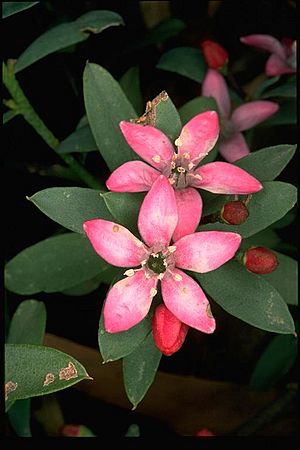Philotheca myoporoides subsp. brevipedunculata facts for kids
Quick facts for kids Philotheca myoporoides subsp. brevipedunculata |
|
|---|---|
 |
|
| This plant growing in the Australian National Botanic Gardens | |
| Scientific classification |
|
| Kingdom: | Plantae |
| Clade: | Tracheophytes |
| Clade: | Angiosperms |
| Clade: | Eudicots |
| Clade: | Rosids |
| Order: | Sapindales |
| Family: | Rutaceae |
| Genus: | Philotheca |
| Species: | |
| Subspecies: |
P. m. subsp. brevipedunculata
|
| Trinomial name | |
| Philotheca myoporoides subsp. brevipedunculata Bayly
|
|
Philotheca myoporoides subsp. brevipedunculata is a special type of flowering plant. It belongs to the Rutaceae family, which also includes citrus fruits like oranges! This plant is found only in New South Wales, Australia, meaning it is endemic there. It's a shrub with cool oblong or egg-shaped leaves and pretty white or pink flowers. You'll usually find these flowers growing alone or in small groups of up to three where the leaves meet the stem.
Contents
What Does This Plant Look Like?
Philotheca myoporoides subsp. brevipedunculata is a shrub that usually grows to be about 1.8 to 2 meters tall. That's taller than most kids! Its stems are smooth (which means glabrous) and have lots of tiny, bumpy glands.
Leaves and Flowers
The leaves of this plant are tough and leathery. They are shaped like an oblong or an egg, with the narrower part closer to the stem. Each leaf is about 10 to 30 millimeters long and 5 to 10 millimeters wide. They also have a small point at the very tip.
The flowers are usually found one by one, but sometimes you might see them in groups of two or three, or very rarely, four. They grow from the spots where the leaves join the stem. Each flower has a short stalk, called a peduncle, which is up to 2 millimeters long. Then, each flower sits on an even thinner stalk, called a pedicel, which is 4 to 8 millimeters long.
The petals of the flowers are wide and oval-shaped, about 8 millimeters long. They have a noticeable ridge down the middle, like the keel of a boat. Inside the flower, the stamens (the parts that make pollen) are separate from each other and have tiny hairs near their base. This plant mostly blooms in spring and autumn.
How This Plant Got Its Name
This special subspecies was first officially described in 1998. A scientist named Michael Bayly wrote about it in a science journal called Muelleria. That's how it got its scientific name!
Where Does This Plant Grow?
You can find Philotheca myoporoides subsp. brevipedunculata in the south-eastern part of New South Wales. It grows from the coastal areas all the way up to the escarpment ranges. This includes places like Sassafras and the Moruya district.


